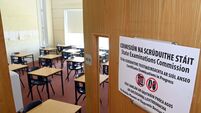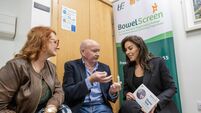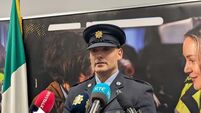Leaving Cert art students took on the unknown as new curriculum makes positive debut

Students at Glanmire Community College Robyn Kelly, Jack Mooney and Caitlin McGregor are all set for the Art Leaving Cert examination on Thursday. Picture: Larry Cummins
Leaving Cert art students took a trip into the unknown today as the new curriculum was examined for the first time in a paper that mixed the contemporary with the classic like the Romanesque, Impressionism and Baroque.
The State exams continued this Thursday afternoon with Leaving Cert art and Junior Cycle wood technology.
The winning artwork from the Zurich Portrait Prize 2022 by Dublin artist David Booth, a still from the animated ‘Wolfwalks’ and Nike Air Force 1s illustrated with work by artist Ruohan Wang appeared among questions on the higher-level paper.
On the ordinary level paper, Philip Treacy’s Lightning Bolt Hat for Lady Gaga made an appearance, as did Cork city’s famous quayside mural by Curtis Hylton, the Kingfisher.
The written exam on Thursday is worth 30% overall of a students' final grade in the subject with the remaining 70% already completed through project work.
“It was the first year for the new art history curriculum to be examined”, teacher and subject representative with the Teachers’ Union of Ireland (TUI) Clodagh O’Hara said.
“It wasn’t too unlike what we’d seen before over the past few years, but there was something there for everybody both on the higher level and ordinary level paper.
“Higher level maybe I would say was a little bit wordy, maybe a little too highbrow for the age of the students going into the exam, it might have been a little too third-levely.”
One example of this was a question on the Romanesque and Gothic, which asked students to discuss the influence of pilgrimage on the art and architecture of the Romanesque period.
“But otherwise, I’m pretty happy. What I really loved was the short questions, which were a whole new ballgame for the students. We haven’t had that on the curriculum before.
“They had to choose five questions out of the selection so there was something there for everybody as well.”
Another question on this year’s paper she liked asked students to discuss the work of two post-1960 Irish artists, whose work communicates any social and/or political messages.
“I’d be thinking here about the artist Spicebag, and their work which was kind of a rehash of the evictions during the famine times and looking at it in terms of the eviction ban being lifted this year.
“There was good selection there, definitely. The ordinary paper as well was lovely, very doable.”
Declan Kelly, art teacher with the Institute of Education, agreed the new exam format had a positive debut.
Section A was a “mixed bag,”, he added, with some very straightforward but one or two that might unsettle in an exam setting.
“In section B and section C, the examiners read the room and created a selection of questions that would really fit the students.
“The focus of section A was to get students thinking on their feet, engaging their higher order thinking to reassess and react rather than regurgitate,” Mr Kelly said.
“The first question on David Booth was lovely.”
[media=cloud]https://www.documentcloud.org/documents/23848633-leaving-art-ordinary?responsive=1&title=1[/media]
“As a well-known contemporary Irish artist, Booth’s style and how to discuss it would have been well known to those that are alert to the current art world.”
However, he thought question 5, which focused on the topical issue of galleries and their funding, offered students a chance to say so much that getting it all to fit in the given spaces posed the bigger challenge.
Section B, Europe and the wider world, and Section C, Ireland and its place in the wider world, were both “lovely”, he added.
“Rather than asking the students to perform a complex reimagining of the material, they sought to test a solid grasp of the fundamentals.”
“All the questions, whether on pre-Christian, the Baroque, or Impressionism, were fair and generous opportunities for students to show what they have studied.”











